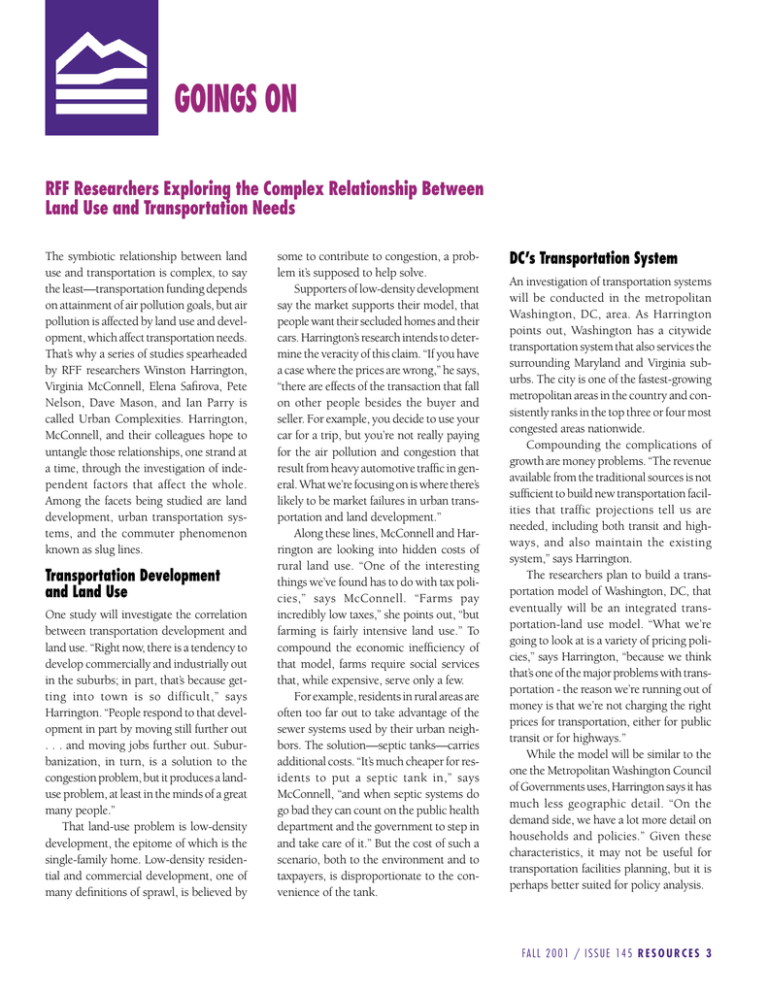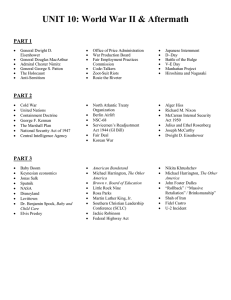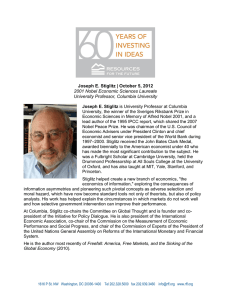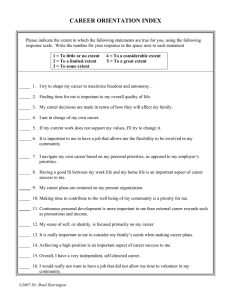GOINGS ON DC’s Transportation System
advertisement

GOINGS ON RFF Researchers Exploring the Complex Relationship Between Land Use and Transportation Needs The symbiotic relationship between land use and transportation is complex, to say the least—transportation funding depends on attainment of air pollution goals, but air pollution is affected by land use and development, which affect transportation needs. That’s why a series of studies spearheaded by RFF researchers Winston Harrington, Virginia McConnell, Elena Safirova, Pete Nelson, Dave Mason, and Ian Parry is called Urban Complexities. Harrington, McConnell, and their colleagues hope to untangle those relationships, one strand at a time, through the investigation of independent factors that affect the whole. Among the facets being studied are land development, urban transportation systems, and the commuter phenomenon known as slug lines. Transportation Development and Land Use One study will investigate the correlation between transportation development and land use. “Right now, there is a tendency to develop commercially and industrially out in the suburbs; in part, that’s because getting into town is so difficult,” says Harrington. “People respond to that development in part by moving still further out . . . and moving jobs further out. Suburbanization, in turn, is a solution to the congestion problem, but it produces a landuse problem, at least in the minds of a great many people.” That land-use problem is low-density development, the epitome of which is the single-family home. Low-density residential and commercial development, one of many definitions of sprawl, is believed by some to contribute to congestion, a problem it’s supposed to help solve. Supporters of low-density development say the market supports their model, that people want their secluded homes and their cars. Harrington’s research intends to determine the veracity of this claim. “If you have a case where the prices are wrong,” he says, “there are effects of the transaction that fall on other people besides the buyer and seller. For example, you decide to use your car for a trip, but you’re not really paying for the air pollution and congestion that result from heavy automotive traffic in general. What we’re focusing on is where there’s likely to be market failures in urban transportation and land development.” Along these lines, McConnell and Harrington are looking into hidden costs of rural land use. “One of the interesting things we’ve found has to do with tax policies,” says McConnell. “Farms pay incredibly low taxes,” she points out, “but farming is fairly intensive land use.” To compound the economic inefficiency of that model, farms require social services that, while expensive, serve only a few. For example, residents in rural areas are often too far out to take advantage of the sewer systems used by their urban neighbors. The solution—septic tanks—carries additional costs. “It’s much cheaper for residents to put a septic tank in,” says McConnell, “and when septic systems do go bad they can count on the public health department and the government to step in and take care of it.” But the cost of such a scenario, both to the environment and to taxpayers, is disproportionate to the convenience of the tank. DC’s Transportation System An investigation of transportation systems will be conducted in the metropolitan Washington, DC, area. As Harrington points out, Washington has a citywide transportation system that also services the surrounding Maryland and Virginia suburbs. The city is one of the fastest-growing metropolitan areas in the country and consistently ranks in the top three or four most congested areas nationwide. Compounding the complications of growth are money problems. “The revenue available from the traditional sources is not sufficient to build new transportation facilities that traffic projections tell us are needed, including both transit and highways, and also maintain the existing system,” says Harrington. The researchers plan to build a transportation model of Washington, DC, that eventually will be an integrated transportation-land use model. “What we’re going to look at is a variety of pricing policies,” says Harrington, “because we think that’s one of the major problems with transportation - the reason we’re running out of money is that we’re not charging the right prices for transportation, either for public transit or for highways.” While the model will be similar to the one the Metropolitan Washington Council of Governments uses, Harrington says it has much less geographic detail. “On the demand side, we have a lot more detail on households and policies.” Given these characteristics, it may not be useful for transportation facilities planning, but it is perhaps better suited for policy analysis. FA L L 2 0 0 1 / I S S U E 1 4 5 R E S O U R C E S 3 GOINGS ON Harrington and his colleagues will be able to plot the intersection of travel and development in the metropolitan area. “Once we get that,” says Harrington, “we’ll be able to look at one of the major issues facing government officials in the area, which is how can strict limitations be placed on land use without affecting the price of transportation.” McConnell adds, “We’re looking at the costs of different land uses in terms of pro- vision of infrastructure like schools and roads.” McConnell says she will be asking, “Is the infrastructure being priced correctly?” Slug Lines Tangentially related to the DC study is a separate study of what have come to be known as slug lines, which can be found only in the Washington, DC, area and Oakland, Calif. Slug lines are the grass-roots phenomenon that brings commuters in need of a ride together with complete strangers—drivers who need passengers in order to use high-occupancy-vehicle lanes. With car pool use down 36% in the Washington area between 1980 and 1990, and another 24% in the last 10 years, Harrington and Safirova think there’s something to be learned from this flourishing trend, including how to expand the concept to other areas. Disagreeing with the Climate Agreement U.S. Waits as Ratification Process Begins The world climate negotiations over the past five months have been hailed as a significant achievement in international diplomacy and politics. But, while some 160 nations have compromised on language for the Kyoto Protocol and set the stage for individual country ratification of the treaty, the United States withdrew last March. Ironically, many of the deals struck since then basically reflect policies the United States has long favored. Virtually all the important compromises addressed the economic cost of meeting a country’s Kyoto target. But none involved enforceable actions, leaving one to wonder what has actually been achieved. After the negotiations broke down at the conference in The Hague in November 2000, they resumed last July in Bonn. There the environmental diplomats reached agreement in principle on most of the outstanding disputes, but many contentious details were left to a further conference in Marrakech, Morocco, in November. As defined by the agreements reached there, the Kyoto treaty will now go to the governments of most of the world’s countries—but not the United States—for ratification. 4 R E S O U R C E S FA L L 2 0 0 1 / I S S U E 1 4 5 Changes made in this process that coincide with U.S. interests include these: • The long and contentious debate between the European Union and the United States over “supplementarity,” that is, what limits should be placed on permit trading as a means of meeting Biological sinks are generally forests, although they can include various types of agricultural products, that capture (sequester) carbon from the atmosphere. Kyoto commitments, was resolved. Participants agreed no quantitative limits should be placed on trading; this mirrors the United States’ position. • The use of forest and cropland management to increase the amount of carbon sequestered in biological sinks during the first commitment period was agreed to, subject to some upper bounds. Clashes between the United States and the European Union over these very same sinks was blamed, in part, for the breakdown of the talks in The Hague. • All the forms of greenhouse gas credits (or permits) can be used to meet a country’s commitment. These credits include the purchase of assigned amounts through Annex 1 trading, certified emission reductions obtained through the use of the Clean Development Mechanism (CDM), and emission reduction units obtained through joint implementation within Annex 1 countries. • Afforestation and reforestation projects, which are assumed to be very cost-effective ways to sequester carbon in developing countries, were deemed eligible for the CDM. • A limit on the share of the proceeds (a portion of the revenue raised by a CDM project) derived from CDM projects that would go to developing countries to meet the costs of adaptation to climate change was set at 2% of the certified emission reductions generated from a CDM project. While some might argue that these deals undermine the environmental integrity of the protocol, the damage seems GOINGS ON small. The uncertainty around the proper accounting for biological sinks engenders the greatest concern, but the use of sinks in Article 3 is strictly limited and the eligibility of forest projects in the CDM can be properly managed through the CDM certification process and should not raise too many concerns. However, all is not well with the protocol. The targets and timetables of the Kyoto Protocol have at times been called legally binding commitments. Such language suggests that the force of law underlies these commitments. Nothing could be further from the truth. The protocol specifies no legally binding consequences to enforce compliance with these commitments, such as financial penalties. If a party to the protocol fails to meet its commitment by, say, X tons, 1.3 times X tons is deducted from the second commitment-period allocation. However, since the second commitment-period allocation has yet to be negotiated, a noncomplying country has ample opportunity to factor its first period overages and the 30% “surcharge” into its second commitment period negotiating position. These provisions of the protocol provide no legal or economic incentives for compliance, except that a country is not eligible to trade if it is out of compliance. If there are no strong legal or economic incentives for compliance, then surely some parties to the protocol will choose not to comply if the cost of compliance becomes too great. A noncomplying party has no incentive to purchase permits on the international market, thereby reducing permit demand and prices. If permit prices depend on compliance and there are no strong incentives for compliance, how well would one expect an international permit market to function? The answer seems to be not well at all. The value of assigned amounts or CDM credits traded on the international market depends on the demand for these assets, and demand exists only if compliance is ensured. Uncertainty over compliance translates into uncertainty over the value of permits, relegating permits in the market to nothing more than highly speculative investments—not the sort of assets upon which a multibillion-dollar global trading system would rest. If a robust international market in greenhouse gases is one of the best ways to ensure cost-effective greenhouse gas control for decades to come, then the current approach to compliance in the protocol seems to lay a very poor foundation upon which to build a robust market. RFF Board Member Joseph E. Stiglitz Shares Economics Nobel Prize RFF Board Member Joseph E. Stiglitz recently was honored with the 2001 Bank of Sweden Prize in Economic Sciences in Memory of Alfred Nobel for his innovative analysis of markets with asymmetrical information. “Our scholars look to our board for inspiration, guidance, and validation of their research. Imagine the thrill of having not just one, but now two Nobel laureates on our governing body,” says Paul Portney, RFF's president. “Stiglitz's research back in the 1970s has informed much of our own work on improving regulatory policy.” A market with asymmetrical information refers to a situation where agents on one side of a market have much more infor- mation than those on the other side. While textbook examples include insurance and credit markets, in many policy situations, parties subject to governmental regulations have more information regarding their activities than the regulator seeking to alter their behavior. For example, a program that aims to retire an old (and dirtier) type of technology might be disproportionately comprised of plants where the technology has already been mothballed or plants that were already going to make a switch based on their cost characteristics, which are unknown to the regulator. Applying the insights of Joseph Stiglitz and this year’s other Nobel laureates in economics, environmental economists are designing superior regulatory approaches in settings as diverse as water pollution control, greenhouse gas emissions, oil exploration, and fisheries exploitation. Stiglitz, who joined the RFF board in April 1997, is professor of economics, business, and international affairs at Columbia University. He shared this year’s economics prize with A. Michael Spence of Stanford and George A. Akerlof of the University of California, Berkeley, who separately also made significant contributions to the literature on markets with asymmetric information. RFF Board Member Robert M. Solow of the Massachusetts Institute of Technology won the Nobel in 1987. FA L L 2 0 0 1 / I S S U E 1 4 5 R E S O U R C E S 5




